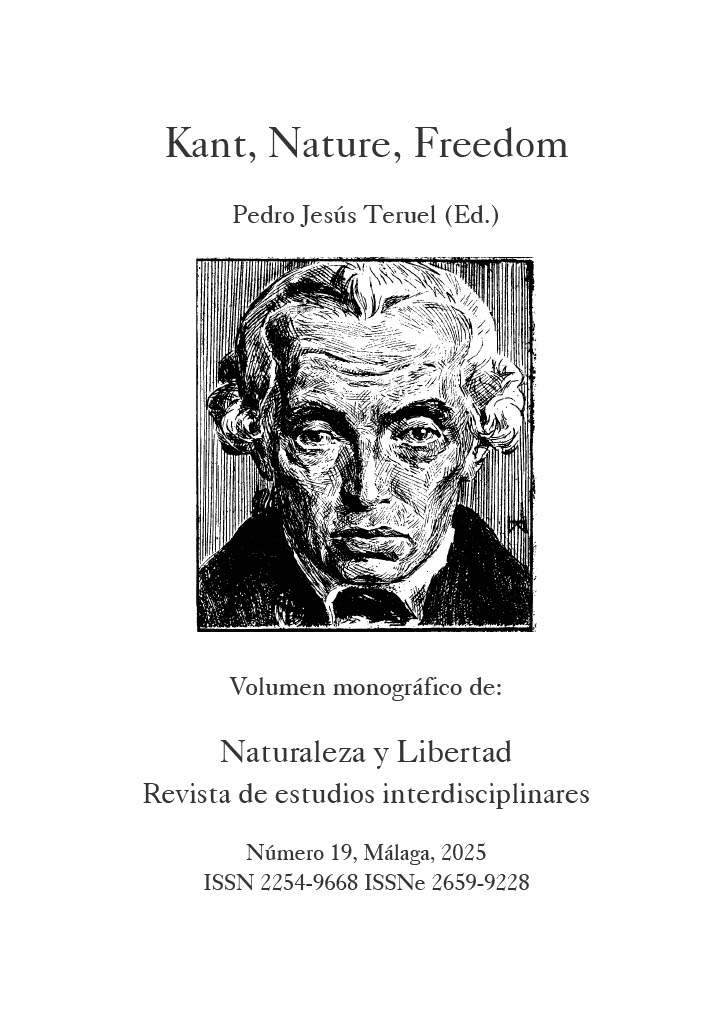«Absolute, non comparative magnum»: The connotation of the mathematical in the Kantian Sublime
DOI:
https://doi.org/10.24310/nyl.19.2025.21016Keywords:
Kant, Sublime, Mathematical, Synthesis, Composition, MagnitudeAbstract
In the Analytic of the Sublime in Kant's Critique of the Power of Judgment, the connection between pure aesthetic judgment and mathematics appears at first sight as both surprising and unprecedented within Kantian aesthetics. The sublime is mathematical (as well as dynamical), leaving the attentive reader to ponder how this relationship between the mathematical and a feeling that claims universal communicability is possible. This distinction between mathematical and dynamic forms of the sublime is entirely original and lacks historical precedent. Neither Pseudo-Longinus nor Joseph Addison nor Edmund Burke nor Henry Home nor John Baillie (Scheck 2009, pp. 34ff), nor even Kant himself in his pre-critical work, Observations on the Feelings of the Beautiful and the Sublime (1764),[1] made this distinction between two types of the sublime: mathematical and dynamical. Moreover, Kant emphasizes the autonomy of pure aesthetic judgments from both particular concepts and specific sensations, as neither of these representations constitutes the foundation of aesthetic judgment. Consequently, the origin of the association between the sublime and the mathematical, as well as the dynamical, remains opaque. This article will focus exclusively on the nexus between the mathematical and the sublime, invoking the synthesis of composition from Kant's First Critique as a possible explanation of this Kantian innovation.
[1] Kulenkampff claims that Burke's influence on the sublime is not limited to Observations on the Feeling of the Beautiful and the Sublime, but extends to the Critique of the Power of Judgment: „So ist zum Beispiel bei Burke in der Unterscheidung von Endlichkeit und Rissigkeit als Quellen des Erhabenen (verg. Burkes Schrift Kap. IV, Nr. 13. u. ö.) phänomenologisch die Unterscheidung zwischen dem Mathematisch-Erhabenen und dem Dynamisch-Erhabenen vorgebildet. Ebenso findet sich bei Burke, allerdings ganz psychologisch gedacht, die Erklärung, daß die psychische Wirkung des Erhabenen auf einem Wechsel zwischen Krampf und Lösung beruhe (IV, 3) und das positive Ergebnis eine reinigende Erschütterung sein kann (IV, 7) (verg. KdUB 80ff. u. 102ff.; 75)» (Kulenkampff (1974): 11). It is possible that Kant took the empirical perspective of Burke's division of the sublime to give it a systematic critical foundation in his philosophy, however, Burke does not consider the mathematical in any way in his study of the beautiful and the sublime. Consequently, it remains an original division in Kantian critical aesthetics.
Downloads
Metrics
No metrics found.
References
Aagaard-Mogensen, Lars (Hrsg.) (2017): The Possibility of the Sublime. Newcastle upon Tyne: Cambridge Scholars Publishing.
Brady, Emily (2013): The Sublime in Modern Philosophy: Aesthetics, Ethics, and Nature. Cambridge: Cambridge University Press.
Clewis, Robert (2009): The Kantian Sublime and the Revelation of Freedom, Cambridge: Cambridge University Press.
Forsey, Jane (2007): «Is a Theory of the Sublime Possible?». In: Journal of Aesthetics and Art Criticism 65, S. 381-389.
Golob, Sacha (2019): «Can there be a Finite Interpretation of the Kantian Sublime?». In: Kant Yearbook 11. Nr. 1, S. 17-40.
Kant, Immanuel (2019): Critique of Pure Reason. Translated by Paul Guyer and Allen W. Wood. Cambridge: Cambridge University Press.
Kant, Immanuel (2007): Critique of the Power of Judgment. Translated by Paul Guyer and Eric Matthews. Cambridge: Cambridge University Press.
Kant, Immanuel (1900 ff): Gesammelte Schriften. Ed.: Bd. 1–22 Preußische Akademie der Wissenschaften, Bd. 23 Deutsche Akademie der Wissenschaften zu Berlin, from Bd. 24 Akademie der Wissenschaften zu Göttingen: Berlin.
Kant, Immanuel (2009): Kritik der Urteilskraft. Edited by Heiner Klemme. Hamburg: Felix Meiner Verlag.
Kulenkampff (1974), Jens: Materialien zu Kants «Kritik der Urteilskraft», Frankfurt am Main: Suhrkamp Verlag.
Lyotard, Jean-François (1994): Die Analytik des Erhabenen. Kant-Lektionen. München: Fink.
McBay Merritt, Melissa (2012): «The Moral Source of the Kantian Sublime». In The Sublime: from Antiquity to Present (Ed. Timothy Costelloe), S. 37-49.
Órdenes Azúa, Paula (2023): Teleologische Erhabenheit der Vernunft bei Kant. Ein paradoxer Beweis der Einheit der Vernunft aus der Dualität des Erhabenen. Ber-lin/Boston: Walter de Gruyter.
Park, Kap Hyun (2008): Kant über das Erhabene. Rekonstruktion und Weiterführung der kritischen Theorie des Erhabenen Kants. Würzburg: Königshausen u. Neumann.
Pries, Christine (1995): Übergänge ohne Brücken. Kants Erhabenes zwischen Kritik und Metaphysik. Berlin: Akademie Verlag.
Scheck, Daniel (2009): «Lo sublime en la modernidad: De la retórica a la ética» Revista Latinoamericana de Filosofía, vol.35, n.1:35-83.
Sircello, Guy (1993): «How Is a Theory of the Sublime Possible?». In: Journal of Aes-thetics and Art Criticism 51, S. 541–550.
Wenzel, Christian H. (2005): An Introduction to Kant’s Aesthetics. Core Concepts and Problems. Malden: Blackwell Publishing.
Zuckert, Rachel (2019): «Kant’s Account of the Sublime as Critique». In: Kant Year-book 11, S. 101-120.
Published
How to Cite
Issue
Section
License
Copyright (c) 2025 Nature & Freedom. Journal of Interdisciplinary Studies

This work is licensed under a Creative Commons Attribution-NonCommercial-ShareAlike 4.0 International License.
Those authors who have publications with this journal, accept the following terms:
1. Copyright and licensing information are clearly described on the journal’s web site: all content published in Naturaleza y Libertad is open acces without limit, and are subject to the Attribution-NonCommercial-ShareAlike 4.0 International (CC BY-NC-SA 4.0) license. The full text of which can be consulted at https://creativecommons.org/licenses/by-nc-sa/4.0/
2. It is the responsibility of the authors to obtain the necessary permissions for the images that are subject to copyright. The authors whose contributions are accepted for publication in this journal will retain the non-exclusive right to use their contributions for academic, research and educational purposes, including self-archiving or deposit in open access repositories of any kind. The electronic edition of this magazine is edited by the Editorial de la University of Malaga (UmaEditorial), being necessary to cite the origin in any partial or total reproduction.
3. This journal allows and encourages authors to publish papers on their personal websites or in institutional repositories, both before and after their publication in this journal, as long as they provide bibliographic information that accredits, if applicable, your posting on it.
4. In no case will anonymous papers be published.





18.png)













